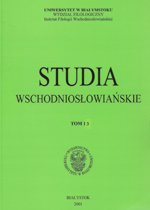Tabliczki z Podebłocia w świetle inskrypcji greckich na Rusi Kijowskiej
Tablets From Podebłocie in Comparison With the Greek Inscriptions From Kievan Rus
Author(s): Leszek BednarczukSubject(s): Christian Theology and Religion, Archaeology, Theoretical Linguistics, Historical Linguistics, 6th to 12th Centuries, Eastern Orthodoxy
Published by: Wydawnictwo Uniwersytetu w Białymstoku
Keywords: Kievan Rus; archaeological research; Greek alphabet; Cyrillic;
Summary/Abstract: In 1986, during excavations at Podebłocie (a locality near Vistula c. 100 km south of Warsaw) 3 clay tablets dated between IX–XI centuries A. D. were found. Professor T. Wasilewski (1987) interpreted the inscription as placed on them as I X C H which represents the Byzantine Christogram: IC/XC – NI/KA = IHCOYC XPICTOCNIKA. This Christogramm occurs often in different inscriptions in KievanRus’, namely in 3 stones of duce Borys in Dvina near Połock, 1128, in Cross on stone of duce Rogvolod near of town Druck as well as in of Kievanencolpions. In the territory of Poland were discovered over 50 encolpions. One of them fund in excavation Horodyszcze in Trepcza near Sanok (XII–XIII c.) has Christogram IC / XC N (K ), whereas X P was engravedon the bronze encolpion in Ostrów Lednicki near Gniezno (first half of XI c.). As it seems, also tablets from Podebłocie are of Church Russian origin. Its author might be captive Orthodox believer taken during Kiev expedition of Bolesław the Brave in 1018 and then settled in Podebłocie, where he engraved inscription in the tablets.
Journal: Studia Wschodniosłowiańskie
- Issue Year: 2014
- Issue No: 14
- Page Range: 143-150
- Page Count: 8
- Language: Polish

